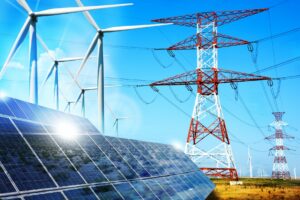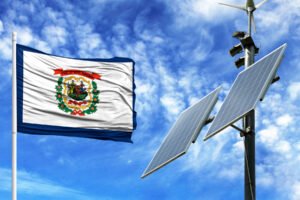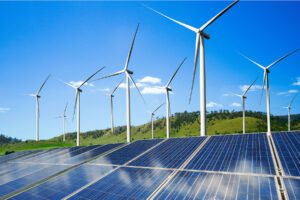 On September 8, 2021, the Department of Energy (DOE) released its Solar Futures Study providing a blueprint for the role of solar energy in decarbonizing the nation’s power sector. The 310-page Study outlines a future in which solar provides 40% of the nation’s electricity supply by 2035 through cost reductions, technological improvement, rapid deployment, and supportive policies. And, with the electrification of buildings and the transportation sector, solar could also power 30% of all building end uses and 14% of transportation end uses by 2050.
On September 8, 2021, the Department of Energy (DOE) released its Solar Futures Study providing a blueprint for the role of solar energy in decarbonizing the nation’s power sector. The 310-page Study outlines a future in which solar provides 40% of the nation’s electricity supply by 2035 through cost reductions, technological improvement, rapid deployment, and supportive policies. And, with the electrification of buildings and the transportation sector, solar could also power 30% of all building end uses and 14% of transportation end uses by 2050.
The Study identifies several policy initiatives needed to support the deployment of solar at this scale, including decarbonization targets, R&D investments and cost reductions, changes to wholesale electricity market regulation, and transmission development, to name a few. In order to meet the 40% by 2035 goal, the Study estimates that the U.S. must install an average of 30 GW of solar capacity per year between now and 2025 and 60 GW per year from 2025-2030, with a total of 1,000 GW of solar deployed by 2035. If the solar industry sees this level of growth, the Study estimates that the industry could employ up to 1.5 million people by 2035. The Study also highlights the important role that battery storage and demand-side management will play given that solar power varies based on daily and seasonal patterns.
With solar power currently providing approximately 3% of the nation’s electricity supply, the DOE’s 40% goal will be contingent on many factors supporting the industry in the coming years, including cost reductions, supportive policies, and widespread deployment.
 A financial rebound is in progress as COVID-19 becomes less of a driver to business and our general livelihood, and it is one that is apparent in the renewables sector. Experts see growth fueled not just by pent-up demand, but also growing attention to ESG considerations and renewables’ financial advantages.
A financial rebound is in progress as COVID-19 becomes less of a driver to business and our general livelihood, and it is one that is apparent in the renewables sector. Experts see growth fueled not just by pent-up demand, but also growing attention to ESG considerations and renewables’ financial advantages.
Corporate merger and acquisition activity was up significantly with solar developers expanding their pipelines, oil and gas companies diversifying into renewables, and funds buying up renewable assets.
According to Mercom CEO Raj Prabhu, Solar project acquisitions reached a record high in the second quarter, he said, with more than 24.7 GW of capacity acquired. That total came from 34 corporate M&A deals, compared to 20 in the first quarter of this year and 13 in the second quarter of 2020.
In the first half of 2021, solar project acquisitions reached 39.3 GW, more than doubling the 14.7 GW acquired in the first half of 2020.
Venture capital funding in particular has experienced a strong recovery. Funding for VC was 680% higher in the first half of the year, compared with last year, with $1.6 billion raised in 26 deals, according to Mercom.
Renewables have been rapidly gaining market share for years. In 2020, the United States saw its fifth consecutive year of renewables consumption growth, reaching a record high of 12% of the country’s total consumption, according to the U.S. Energy Information Administration (EIA).
EIA estimates solar energy accounted for about 11% of last year’s renewable energy consumption, and “overall, 2020 U.S. solar consumption increased 22% from 2019.”
By comparison, the agency said fossil fuel consumption fell last year by 9% to “the lowest level in nearly 30 years.”
The trend is represented globally as well. The International Energy Agency’s (IEA) most recent market update, released in May, found renewable electricity capacity added in 2020 rose by 45% to 280 GW.
“Solar PV installations will continue to break new records, with annual additions forecast to reach over 160 GW by 2022,” IEA said in its analysis. “That would be almost 50% higher than the level achieved in 2019 prior to the pandemic, affirming solar’s position as the ‘new king’ of global electricity markets.”
Corporate solar interest surges as companies exit pandemic and turn focus to ESG issues | Utility Dive
In another sign of various sectors of the energy industry coming together to advance decarbonization, Enterprise Products Partners LP, a company focused on pipeline, storage and natural gas processing, among other services and products to the energy industry, signed a virtual power purchase agreement for solar energy from the Space City Solar project located in Wharton County, Texas. “We are committed to being a responsible steward of the environment, including using energy sustainably across our footprint,” A.J. “Jim” Teague, co-CEO of the Houston-based midstream company’s general partner, said in a statement on March 1. The PPA made with EDF Renewables North America is the result, Teague said, of an initiative launched by Enterprise Products in 2020 to expand solar power purchasing and/or installations across its system. “We estimate that by 2025, approximately 25% of our power will be from renewable resources.” The Space City Solar project is expected to commence construction in Summer 2021 and begin delivery of clean electricity in Summer 2022. The power purchase agreement between EDF Renewables and an affiliate of Enterprise Products was for a second tranche of the project for 100 MWac/132 MWdc. The project’s total capacity is up to 345 MWac/455 MWdc. Approximately 300 jobs are expected to be created during the construction phase with more than $30 million generated in new tax revenue over the operating life for Wharton County taxing entities, according to a joint release from Enterprise and EDF.
EDF Renewables North America Signs Virtual Power Purchase Agreement with Enterprise Products for Solar Energy | Business Wire
 On February 17, 2021, the Biden Administration announced it will revoke amendments to the Desert Renewable Energy Conservation Plan (DRECP) filed during the last days of the Trump Administration. The DRECP was a collaborative, interagency planning effort finalized in 2016 that was intended to balance renewable energy development and desert conservation across nearly 11 million acres of public lands in the deserts of California. The DRECP carves out certain areas of the deserts for renewable energy development, and makes other areas off limits for reasons including conservation and recreation. The Trump Administration’s amendments would have reduced the number of areas where renewable energy development was off limits, opening up an additional 800,000 acres for renewable energy development. In a statement from the Bureau of Land Management, it was unnecessary to reopen and reconsider the DRECP, which had been developed after years of collaboration and stakeholder input. Renewable energy development in the DRECP land area will continue on under the original plan.
On February 17, 2021, the Biden Administration announced it will revoke amendments to the Desert Renewable Energy Conservation Plan (DRECP) filed during the last days of the Trump Administration. The DRECP was a collaborative, interagency planning effort finalized in 2016 that was intended to balance renewable energy development and desert conservation across nearly 11 million acres of public lands in the deserts of California. The DRECP carves out certain areas of the deserts for renewable energy development, and makes other areas off limits for reasons including conservation and recreation. The Trump Administration’s amendments would have reduced the number of areas where renewable energy development was off limits, opening up an additional 800,000 acres for renewable energy development. In a statement from the Bureau of Land Management, it was unnecessary to reopen and reconsider the DRECP, which had been developed after years of collaboration and stakeholder input. Renewable energy development in the DRECP land area will continue on under the original plan.
 On February 11, 2021, FERC Chairman Richard Glick discussed plans to develop new incentives to support the buildout of transmission infrastructure to meet the ever-growing demand for electricity and the continued growth of renewable projects across the country. As states issue long term net-zero and renewable energy policy goals, and in turn incentivize development of additional power generation facilities, upgrades and construction of new transmission infrastructure will be needed to carry forth that driving force. Chairman Glick provided that “We do have a duty to figure out where the industry is going and recognize the fact that there is going to be a lot more demand for electricity.” “I think we have to figure out policies that will hopefully promote greater investment in the transmission grid to facilitate access to cleaner resources.” For additional information on Chairman Glick’s policy forecast, please click here.
On February 11, 2021, FERC Chairman Richard Glick discussed plans to develop new incentives to support the buildout of transmission infrastructure to meet the ever-growing demand for electricity and the continued growth of renewable projects across the country. As states issue long term net-zero and renewable energy policy goals, and in turn incentivize development of additional power generation facilities, upgrades and construction of new transmission infrastructure will be needed to carry forth that driving force. Chairman Glick provided that “We do have a duty to figure out where the industry is going and recognize the fact that there is going to be a lot more demand for electricity.” “I think we have to figure out policies that will hopefully promote greater investment in the transmission grid to facilitate access to cleaner resources.” For additional information on Chairman Glick’s policy forecast, please click here.
 Following the passage of West Virginia Senate Bill 583 in early 2020, West Virginia has seen an uptick in the number of new proposed renewable energy projects. SB 583 established a new incentive program supporting the development of renewable energy facilities on former industrial sites. Berkeley County, in the eastern panhandle, recently announced a proposed 100 MW solar facility to be built on a 750 acre brownfield site previously used as a manufacturing facility. Read more.
Following the passage of West Virginia Senate Bill 583 in early 2020, West Virginia has seen an uptick in the number of new proposed renewable energy projects. SB 583 established a new incentive program supporting the development of renewable energy facilities on former industrial sites. Berkeley County, in the eastern panhandle, recently announced a proposed 100 MW solar facility to be built on a 750 acre brownfield site previously used as a manufacturing facility. Read more.
 The recently approved federal spending bill for 2021 appropriations (December 27, 2020) included extensions to the federal solar investment tax credit (ITC) and wind production tax credit (PTC). The ITC and PTC provide significant financial incentives to the growing renewable energy industry. The ITC is a tax credit that can be claimed on federal corporate income taxes for a percent of the cost of a solar photovoltaic (PV) system that is placed in service. The ITC, which was scheduled to step down from 26% to 22% in 2021, has been extended at its current 26% rate for an additional two years through 2023. The PTC is a per-kilowatt-hour (kWh) tax credit for electricity generated using qualified energy resources including wind, and was scheduled to phase down from 60% of the original credit to 40% in 2021. The new spending bill included an extension of the 60% rate for an additional year through 2021. Projects must be commenced prior to the expiration of the new extension deadlines in order to qualify for the current tax credit rate. Please click here for more information.
The recently approved federal spending bill for 2021 appropriations (December 27, 2020) included extensions to the federal solar investment tax credit (ITC) and wind production tax credit (PTC). The ITC and PTC provide significant financial incentives to the growing renewable energy industry. The ITC is a tax credit that can be claimed on federal corporate income taxes for a percent of the cost of a solar photovoltaic (PV) system that is placed in service. The ITC, which was scheduled to step down from 26% to 22% in 2021, has been extended at its current 26% rate for an additional two years through 2023. The PTC is a per-kilowatt-hour (kWh) tax credit for electricity generated using qualified energy resources including wind, and was scheduled to phase down from 60% of the original credit to 40% in 2021. The new spending bill included an extension of the 60% rate for an additional year through 2021. Projects must be commenced prior to the expiration of the new extension deadlines in order to qualify for the current tax credit rate. Please click here for more information.
 On September 8, 2021, the Department of Energy (DOE) released its Solar Futures Study providing a blueprint for the role of solar energy in decarbonizing the nation’s power sector. The 310-page Study outlines a future in which solar provides 40% of the nation’s electricity supply by 2035 through cost reductions, technological improvement, rapid deployment, and supportive policies. And, with the electrification of buildings and the transportation sector, solar could also power 30% of all building end uses and 14% of transportation end uses by 2050.
On September 8, 2021, the Department of Energy (DOE) released its Solar Futures Study providing a blueprint for the role of solar energy in decarbonizing the nation’s power sector. The 310-page Study outlines a future in which solar provides 40% of the nation’s electricity supply by 2035 through cost reductions, technological improvement, rapid deployment, and supportive policies. And, with the electrification of buildings and the transportation sector, solar could also power 30% of all building end uses and 14% of transportation end uses by 2050. A financial rebound is in progress as COVID-19 becomes less of a driver to business and our general livelihood, and it is one that is apparent in the renewables sector. Experts see growth fueled not just by pent-up demand, but also growing attention to ESG considerations and renewables’ financial advantages.
A financial rebound is in progress as COVID-19 becomes less of a driver to business and our general livelihood, and it is one that is apparent in the renewables sector. Experts see growth fueled not just by pent-up demand, but also growing attention to ESG considerations and renewables’ financial advantages. On February 17, 2021, the Biden Administration announced it will
On February 17, 2021, the Biden Administration announced it will  On February 11, 2021, FERC Chairman Richard Glick discussed plans to develop new incentives to support the buildout of transmission infrastructure to meet the ever-growing demand for electricity and the continued growth of renewable projects across the country. As states issue long term net-zero and renewable energy policy goals, and in turn incentivize development of additional power generation facilities, upgrades and construction of new transmission infrastructure will be needed to carry forth that driving force. Chairman Glick provided that “We do have a duty to figure out where the industry is going and recognize the fact that there is going to be a lot more demand for electricity.” “I think we have to figure out policies that will hopefully promote greater investment in the transmission grid to facilitate access to cleaner resources.” For additional information on Chairman Glick’s policy forecast, please click
On February 11, 2021, FERC Chairman Richard Glick discussed plans to develop new incentives to support the buildout of transmission infrastructure to meet the ever-growing demand for electricity and the continued growth of renewable projects across the country. As states issue long term net-zero and renewable energy policy goals, and in turn incentivize development of additional power generation facilities, upgrades and construction of new transmission infrastructure will be needed to carry forth that driving force. Chairman Glick provided that “We do have a duty to figure out where the industry is going and recognize the fact that there is going to be a lot more demand for electricity.” “I think we have to figure out policies that will hopefully promote greater investment in the transmission grid to facilitate access to cleaner resources.” For additional information on Chairman Glick’s policy forecast, please click  Following the passage of West Virginia Senate Bill 583 in early 2020, West Virginia has seen an uptick in the number of new proposed renewable energy projects. SB 583 established a new incentive program supporting the development of renewable energy facilities on former industrial sites. Berkeley County, in the eastern panhandle, recently announced a proposed 100 MW solar facility to be built on a 750 acre brownfield site previously used as a manufacturing facility.
Following the passage of West Virginia Senate Bill 583 in early 2020, West Virginia has seen an uptick in the number of new proposed renewable energy projects. SB 583 established a new incentive program supporting the development of renewable energy facilities on former industrial sites. Berkeley County, in the eastern panhandle, recently announced a proposed 100 MW solar facility to be built on a 750 acre brownfield site previously used as a manufacturing facility.  The recently approved federal spending bill for 2021 appropriations (December 27, 2020) included extensions to the federal solar investment tax credit (ITC) and wind production tax credit (PTC). The ITC and PTC provide significant financial incentives to the growing renewable energy industry. The ITC is a tax credit that can be claimed on federal corporate income taxes for a percent of the cost of a solar photovoltaic (PV) system that is placed in service. The ITC, which was scheduled to step down from 26% to 22% in 2021, has been extended at its current 26% rate for an additional two years through 2023. The PTC is a per-kilowatt-hour (kWh) tax credit for electricity generated using qualified energy resources including wind, and was scheduled to phase down from 60% of the original credit to 40% in 2021. The new spending bill included an extension of the 60% rate for an additional year through 2021. Projects must be commenced prior to the expiration of the new extension deadlines in order to qualify for the current tax credit rate.
The recently approved federal spending bill for 2021 appropriations (December 27, 2020) included extensions to the federal solar investment tax credit (ITC) and wind production tax credit (PTC). The ITC and PTC provide significant financial incentives to the growing renewable energy industry. The ITC is a tax credit that can be claimed on federal corporate income taxes for a percent of the cost of a solar photovoltaic (PV) system that is placed in service. The ITC, which was scheduled to step down from 26% to 22% in 2021, has been extended at its current 26% rate for an additional two years through 2023. The PTC is a per-kilowatt-hour (kWh) tax credit for electricity generated using qualified energy resources including wind, and was scheduled to phase down from 60% of the original credit to 40% in 2021. The new spending bill included an extension of the 60% rate for an additional year through 2021. Projects must be commenced prior to the expiration of the new extension deadlines in order to qualify for the current tax credit rate.